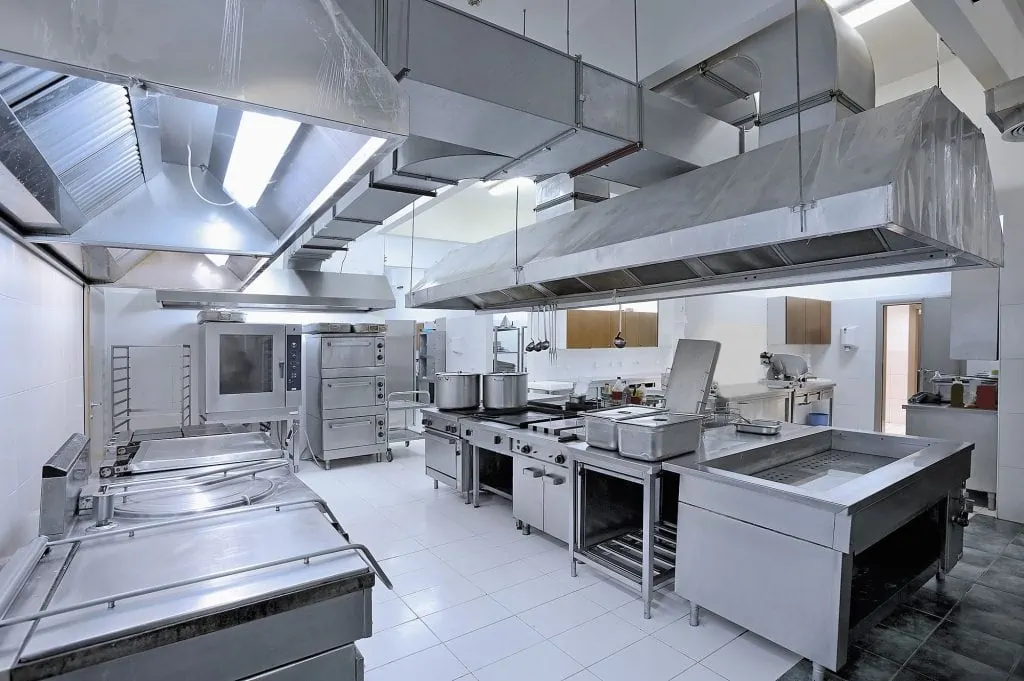
For your culinary artistry to shine, you need to get the restaurant kitchen layout right. Keeping these fundamentals in mind will help make your kitchen organised:
A clear and logical workflow is a must for commercial kitchen layouts. Make sure the layout helps to keep the movement of staff to a minimum, so more work can be done in a shorter time.
Particular focus must be given to storage space in commercial kitchen layouts as it can affect the performance of the restaurant. There are 3 types of storage to consider, refrigerated goods storage, dry goods storage, and crockery storage:
You need a refrigerated space to keep all perishable items at the perfect temperature.
A refrigerated room, or cool room, would be ideal but might not be possible for many business owners due to space and budget issues. Upright refrigerators can be a great option for most restaurants in this case. NovaChill sells amazing high-end commercial fridge & freezer displays that allow for smart use of floor space.
It's important to carefully consider where to place your refrigerator. It must be somewhere where staff can access it easily without disrupting the flow of work.
Dry storage for non-perishable food such as canned and tinned food and spices is essential and will require significant space as well. It’s important they are close to the cooking area, so they can be easily accessed when needed.
Glasses, plates, cutlery, and utensils deserve some love and kitchen space too. You need to find them a clean and grease-free place so that they can live away from other dirty areas of the kitchen, such as cooking and food preparation areas.
You can take advantage of unused wall space by installing wall-mounted shelves. This will give you more storage space for crockery and other kitchen items.
In a restaurant, the cooking area is where all the magic happens. A chef needs his cooking tools and station in order to constantly produce plates of delicious food.
If the cooking area is designed nicely with enough space to move around and all the equipment within arms-reach, the result of his labour will taste far better.
The cleaning space is just as important as any other kitchen space in the design process. So, you'll need space for sinks, dishwashers, drying racks, and other essential tools to keep the kitchen clean.
If you’re at a busy restaurant, fulfilling countless orders, then a sink full of dirty dishes can halt the speed of the operation. In contrast, a well-designed cleaning space will help you clean and dry dishes quickly, freeing up the sink for the next round of plates.
That way, fulfilling a high volume of orders won’t be an issue for you.
It's the place where the final touch is given to the prepared food before it goes to the customer. The serving area should be near the exit to make it easier for the waiter to serve. Also, there should be enough room to arrange the trays and dishes in a presentable manner.
Keep the area well-lit so that you can see what you're doing and ensure that the dish looks as good as it tastes. Placing some food lamps can be a smart idea to keep the food warm. It’s also important to keep the serving area clean to avoid cross-contamination.
It's the vital space of the kitchen from where everything starts. If there's an issue with the food preparation area, then there will be a bottleneck, and you won't be able to fulfil orders on time.
Enough space is needed to chop and mix the ingredients and there should be access to refrigerators, pantries, and the entire storage area.
The perfect spot for the food prep area is close to both the cooking station and the storage areas. If you have to take multiple trips to get materials and ingredients, then you’re wasting your valuable time and energy.
A well-designed layout is vital for a mess-free kitchen. You can choose one of these popular layouts as per your needs:
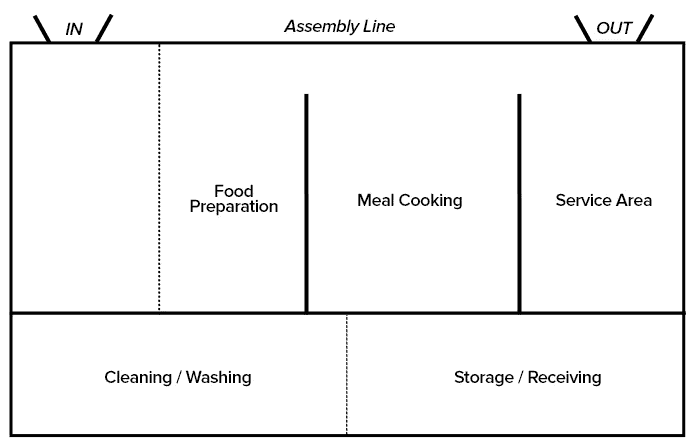
The perfect analogy for the assembly line layout is an apparel manufacturing factory, where each person is responsible for a certain task until an entire piece of cloth is made. But in a commercial kitchen, it's the dishes that are being made instead of clothes.
One station prepares the ingredients, another one cooks them, another makes the dish ready for serving, and the process goes on until the dish is presented to the customer. The system is simple to follow, which allows the staff to produce quality food in a short time and quickly.
• Each station focuses on a specific task, making them extremely efficient in their job
• Thanks to the clear task division, confusion among workers is avoided leading to minimum food preparation time
• The process is ideal for fast food restaurants like KFC and McDonald’s with limited menus
• The layout makes it easier to scale the production of dishes significantly
• Since everything is performed in a specific order, a delay in a particular station will bring the entire operation to halt
• The layout is often high-paced and stressful, thus leading to many employees feeling burned out
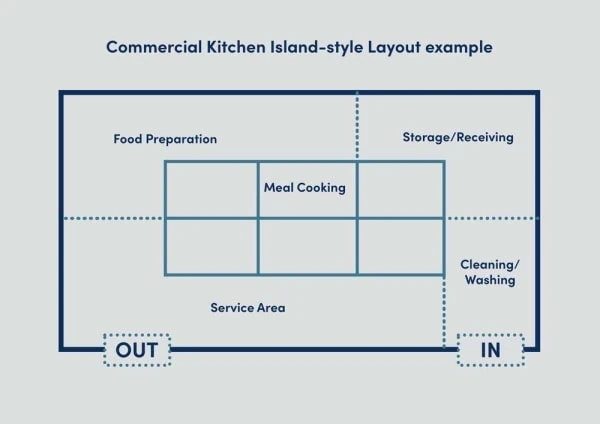
Here, the kitchen is like an island with the meal cooking area being at the centre.
You can compare it to the nucleus of the cell surrounded by other organelles doing their job.
In this layout, you might have the prep station on one side, the storage close to it, and the washing space on the other side. It lets you make a collaborative kitchen as all the members can communicate freely and work together.
This commercial kitchen layout also presents an opportunity for flexibility as tasks and responsibilities can be adjusted as per demand.
• Flexible workflow as tasks can be adjusted as per need to reduce stress on the overloaded staff
• Since the kitchen space is open, communication is far better among the staff
• There’s room for a big counter space for the serving area
• For this system to work, you'll need a large space potentially reducing the dining area
• Sometimes there can be a bit of crowding in the centre which can cause accidents or collisions
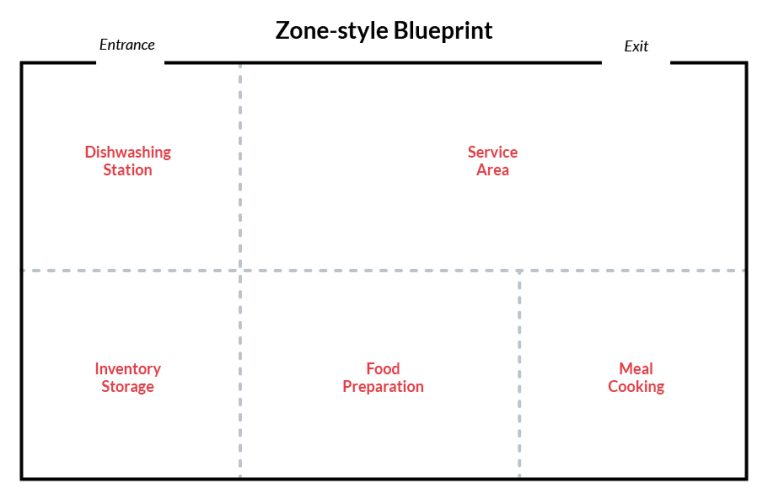
With the zone style layout, you might notice a lot of similarities to the assembly line layout as tasks are divided by zones.
Here, operations are carried out like a choreographed action where each individual has a very specific role to play culminating in a delicious meal. Tasks such as cooking, preparing, storing, and washing are carefully divided into zones in order of sequence.
Restaurants with large and diverse menus typically prefer zone style layout as it's suitable for creating a wide range of dishes.
• Offers the highest level of optimization of space
• Suitable for restaurants with different types of food like curry station, salad station, and frying station
• Allows smooth workflow
• Requires ample kitchen space and can’t be accommodated in a small kitchen
• Multi-tasking is not an option for the staff
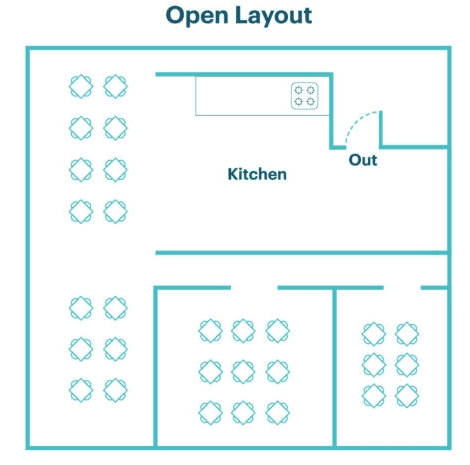
Customers love open layout and appreciate the full view of what's happening behind the scenes.
It can be really fun to watch the food being cooked in front of your eyes, and it also increases trust among the consumers about the cooking process. Placing a glass partition to separate the dining room and the kitchen space will prevent the smoke and odour from reaching the dining area.
The best thing is, with a clear view of the entire kitchen, the executive chef can monitor and communicate far more effectively than any other layouts would allow him. That being said, the organisation is key - as the wrong placement of kitchen equipment can disrupt the entire process and cause chaos.
• Contributes to customer satisfaction and instils their confidence in the restaurant
• The chef can communicate and organize the process in the best manner
• Makes the interior even better by making the kitchen visually appealing
• The odour/smoke may reach the customers affecting their dining experience
• There can be hygiene and allergen controlling issues
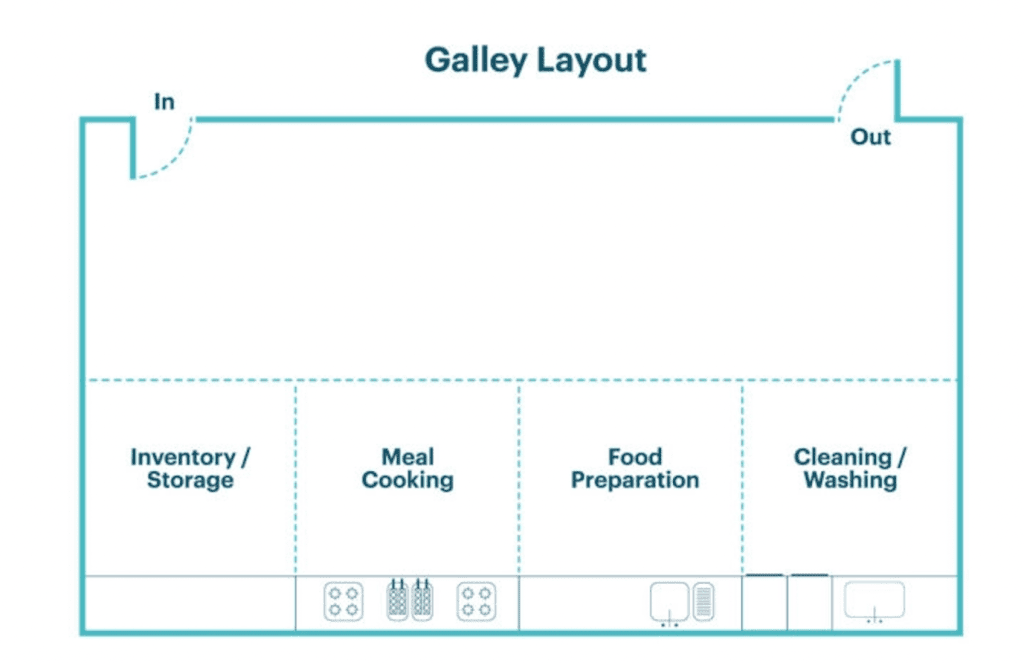
You will see this kitchen layout in smaller restaurants or even food trucks as it offers them the best solution for the shortage of space.
The layout is mainly an elongated kitchen design which utilizes every inch of floor space to streamline the cooking operation. The entire process resembles the ship's galley and that's why it is named as such.
• The best solution for running cooking operations in tight spaces such as a food truck or small kitchen
• Can be completed with a limited budget, as not much kitchen equipment is needed
• Designed for the speedy delivery of food
• Not a good fit for multiple people working together
• Lack of space means limited cooking equipment, reducing the range of dishes you can serve
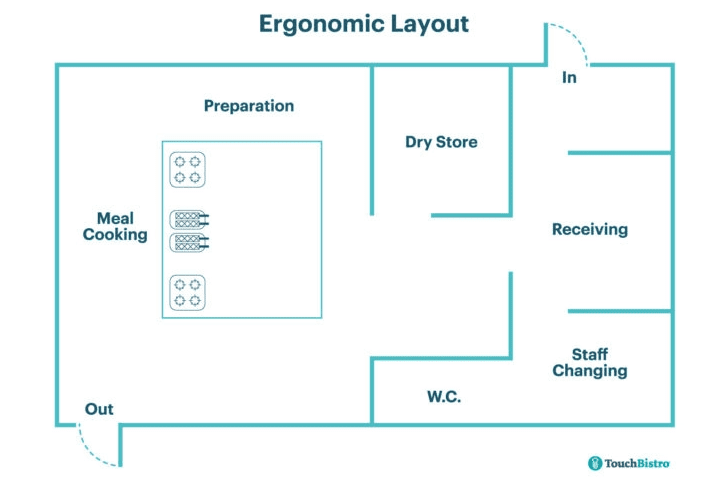
Ergonomic layouts are designed to make the workspace comfortable for the back of house staff with an additional focus on making the cooking operation efficient.
In this layout, cooking equipment placement, countertop height, empty space, and storage are all considered to reduce the physical strain and increase overall output.
By making things easier for the staff, you can ensure that they remain focused on the job at hand and create the best experience for the customers.
• Creates a comfortable and organized working space, resulting in increased job satisfaction
• Designed to boost the productivity of the staff
• A great organization through the smart placement of commercial kitchen equipment and storage
• Can be expensive as you may need to significantly overhaul the entire kitchen system
• Very tough to accommodate in small kitchens
These are some common mistakes you should be careful of:
Cramming a lot of cooking equipment in a small space will deprive your staff of space to move around. It can cause the work to slow down, frustrate the employees, and ruin the customer experience.
So, before you execute the design, carefully measure the space and the equipment and calculate if you can incorporate them into the kitchen.
When the orders are pouring in, you don’t want to spend time finding the ingredients from an unidentifiable heap of storage. That’s why you need to assign enough space for the storage section, so that everything can be properly tracked and used efficiently.
If you have a small kitchen, you can use the vertical space to install shelves and racks. Also, use dead space such as corners, space behind the door and underneath the countertop to store things.
Ignoring health and safety regulations is a recipe for disaster, as that will not only put the health of your staff and customers at risk but also the future of your restaurant.
That's why before you start, learn as much as you can about the local health codes and safety regulations and ensure that the kitchen layout complies with all of them.
Waste disposal stations should be close to the washing area, so you can dispose of food waste, grease, and other rubbish quickly and easily. The bins must have lids to keep unpleasant odours at a minimum.
Don't forget to mark the waste containers clearly and keep them well away from the foodstuff.